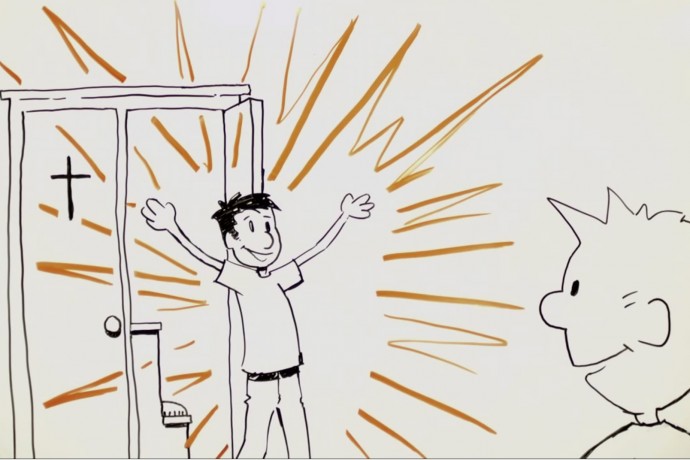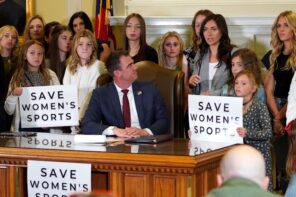Down in the basement of Fordham University Church in the Bronx, the priest struggles to hook up his iPad to the flat screen TV hanging on the wall. With broad shoulders and mitts that swallow mine in a handshake, Father John J. Shea comes off like he could have been one hell of a boxer back in his day. But now he is hunched over the iPad, tapping away in the hopes that something will work.
While Father Shea looks back and forth between tablet and TV, a few Fordham students quietly enter the room. As they take their seats at the wooden tables Father Shea finally wins in his struggle with technology; dozens of thumbnailed videos pop up on the TV.
The students spend most of the next hour watching video clips on topics like baptism and the Eucharist. Between clips Father Shea might say a few words, but nobody responds.
This is a Rite of Christian Initiation of Adults (RCIA) meeting—part of the process of becoming a fully confirmed adult member of the Catholic Church.
The RCIA process has three goals in mind: to teach converts about the Catholic Church, to strengthen their faith, and to help bring converts into the religious community. “This isn’t just joining some club,” Shea tells me. Over the months-long process possible initiates will be evaluated to make sure they’re ready to join the Church. He remembers a Chinese student who knew nothing about Catholicism—“not knowing the Pope from Donald Trump.” She was directed to another RCIA program that would teach her about the Church over the course of a whole year.
“You can trace the history of the Church for thousands of years. There’s something powerful in that to me. If you look at all the absolute shit it’s been through for thousands of years; whether it’s corrupt popes or immoral priests, it always comes out the other side.“
While this group at Fordham isn’t alone in joining a religious organization this year, the move to the Catholic Church is not so common. Pew’s 2014 U.S. Religious Landscape Study showed that between 2007 and 2014 six Catholic adults left the Church for every one who joined the faith. It was the highest rate of departure by a religious denomination in the U.S. And while nearly one-third of U.S. adults were raised in the Catholic tradition, some 13 percent of American adults identify as former Catholics.
A group of millennials joining the Church is even more unlikely. The study showed that only 16 percent of millennials said they were Catholics. At the same time, around 35 percent of millennials self-identified as unaffiliated, the highest percentage of any of the four generational groups.
Millennials’ unaffiliated status is likely due to their increasingly negative view of religious institutions as a whole. Another Pew report released in January of this year says that the percentage of millennials who thought churches and religious organizations had a positive effect on the country went from 73 in 2010 to 55 in 2015. Older generations’ views of religious groups moved in the opposite direction, so by 2015 millennials were the least likely to see religious organizations as having positive effects in the U.S.
Aside from the broader statistics, these millennials’ individual paths to Fordham’s RCIA program are notable in themselves. Damien Strecker, a 33-year-old History Ph.D. candidate, went to Catholic school when he was younger, but was never raised in the faith. He says he “tried out the different flavors” of Christianity by going to some different churches and attended a mosque and a synagogue for a while—but no faith stuck out to him.
His love of the past may have helped lead him to Catholicism today. “You can trace the history of the Church for thousands of years. There’s something powerful in that to me,” he says. “If you look at all the absolute shit it’s been through for thousands of years; whether it’s corrupt popes or immoral priests, it always comes out the other side. I think all that’s faith-affirming for me.”
Twenty-year-old Justin Bujalski sits at the next table. In his second year at Fordham he’s decided to convert to Catholicism after falling out of touch with the Lutheran faith of his childhood.
Across from Justin sits Alexis Verwoert, a 19-year-old freshman. Alexis is actually a bit of an oddity in the RCIA process. She was raised in the Catholic Church, being baptized as an infant and receiving her First Communion a few years after that. But she never finished her confirmation. The bishop at her diocese in Florida made it difficult for her to get confirmed before because of her busy schedule and—she thinks—because of her gender.
“To be Catholic—or to be a part of any religion today—is counter-cultural.”
While she wasn’t confirmed during the Easter Vigil this weekend at Fordham University Church like Damien and Justin, she’ll go through another ceremony with others finishing up their confirmation today at another church in Manhattan.
Back in his office, Father Shea tells me how amazed he is to find young adults like those three looking to join the Catholic Church in this day and age. He slouches into his chair, sinking comfortably into plush black leather. But he gets more riled up when he mentions the “anti-religion, materialistic, consumeristic, pleasure-seeking” culture he sees us living in today.
Raising himself up in his chair, Father Shea talks about the culture war playing out in the streets. My uncomfortable fidgeting goes unnoticed while Father Shea speaks with absolute conviction about the sad state of the world.
“To be Catholic—or to be a part of any religion today—is counter-cultural,” he says. “Today, people’s religion is shopping and games. What goes on at the Superbowl is like a liturgy.” The “secular churches of the mall and the stadium” he refers to are a real grievance.
Shea tells me about a Jesuit priest at Boston College who would say to his students “Who is your God? I’ll tell you who your God is. Tell me what you spend most of your time with. That’s your God.” For Father Shea, the Holy Trinity has been replaced in the hearts of students by the secular trinity of shopping, computers and TV.
But even Father Shea uses tech in his RCIA class. Damien thinks the use of the videos might be the older Jesuit trying to cater to the younger college audience—a good guess, given Father Shea’s assessment of millennial culture.
One of the clips Father Shea plays during class is an animated video on baptism. The poorly drawn cartoon characters wobble around the screen, acting out how the sacrament would have looked centuries ago. In the alternate universe where the creators of South Park are serious Christians instead of masters of satire, this is the cartoon they would make.
At one point Damien stifles a laugh. “In the past few months,” he tells me, “it seems like Father Shea’s been all about this chintzy visual stuff.” A few minutes later Justin has to choke back a laugh of his own during another animated sequence.
But Father Shea doesn’t to notice. The video ends, he says a few words about the sacraments, and clicks play on the next one.





